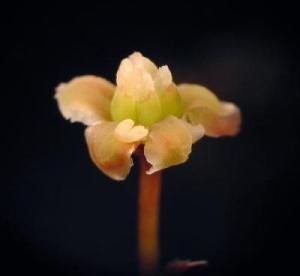非模式基础被子植物Amborella基因组验证:花的起源
来源:《Science》
作者:Srikar Chamala等
时间:2014-01-06

The newly sequenced genome of the Amborella plant will be published in the journal Science on 20 December 2013. The genome sequence sheds new light on a major event in the history of life on Earth: the origin of flowering plants, including all major food crop species. More photos are online at http://science.psu.edu/news-and-events/2013-news/dePamphilis12-2013.
最原始的被子植物互叶梅Amborella已被确定是所有其他存活被子植物的单一姊妹物种,是其他被子植物比较的关键参照物。然而,Amborella不是遗传模型植物,没有现存的遗传图谱、遗传资源或基因组序列。
编辑提要 塑造植物进化 Amborella Trichopoda是唯一的、最基础的现存的开花植物,其基因组优先考虑用于洞察地球上植物生命演化(见亚当斯的观点)。Chamala等人(1516页)结合荧光原位杂交(FISH)、基因组图谱和下一代测序技术验证和组装序列。Amborella基因组计划(10.1126页/科学.1241089)可以推断出被子植物的祖先进化之前的一个全基因组复制事件,Rice等(1468页)发现,众多线粒体基因通过基因水平转移从其他植物获得,近乎包括四个完整的苔藓和藻类线粒体基因组。
Amborella植物测序基因组解决了“达尔文难解之谜”——为什么几百万年前花在地球上突然激增的问题。基因组序列为地球生命史上重大事件提供了理论参考:开花植物的起源,包括所有主要粮食作物品种。2013年12月20日,Amborella基因组测序计划的1篇包括研究分析完整描述以及开花植物研究启示的论文刊登在《科学》杂志。同期《科学》上还发表了关于Amborella基因组不同研究领域的其他2篇论文。
“跨越物种范围的Amborella植物重测序揭示保护影响及最近的主要遗传瓶颈的地理结构,”佛罗里达大学的Pam Soltis评论。一个类似的遗传缩小变异发生在从非洲迁徙的现代欧亚人类种群。(编译:中国科学院成都生物研究所 王芋华,王海燕)
Assembly and Validation of the Genome of the Nonmodel
Basal Angiosperm Amborella
Abstract Genome sequencing with next-generation sequence (NGS) technologies can now be applied to organisms pivotal to addressing fundamental biological questions, but with genomes previously considered intractable or too expensive to undertake. However, for species with large and complex genomes, extensive genetic and physical map resources have, until now, been required to direct the sequencing effort and sequence assembly. As these resources are unavailable for most species, assembling high-quality genome sequences from NGS data remains challenging. We describe a strategy that uses NGS, fluorescence in situ hybridization, and whole-genome mapping to assemble a high-quality genome sequence for Amborella trichopoda, a nonmodel species crucial to understanding flowering plant evolution. These methods are applicable to many other organisms with limited genomic resources.
原文链接:http://www.sciencemag.org/content/342/6165/1516.full
The Amborella Genome and the Evolution of Flowering Plants
Abstract Amborella trichopoda is strongly supported as the single living species of the sister lineage to all other extant flowering plants, providing a unique reference for inferring the genome content and structure of the most recent common ancestor (MRCA) of living angiosperms. Sequencing the Amborella genome, we identified an ancient genome duplication predating angiosperm diversification, without evidence of subsequent, lineage-specific genome duplications. Comparisons between Amborella and other angiosperms facilitated reconstruction of the ancestral angiosperm gene content and gene order in the MRCA of core eudicots. We identify new gene families, gene duplications, and floral protein-protein interactions that first appeared in the ancestral angiosperm. Transposable elements in Amborella are ancient and highly divergent, with no recent transposon radiations. Population genomic analysis across Amborella’s native range in New Caledonia reveals a recent genetic bottleneck and geographic structure with conservation implications.
原文链接:http://www.sciencemag.org/content/342/6165/1241089.full
Horizontal Transfer of Entire Genomes via Mitochondrial Fusion in the Angiosperm Amborella
Abstract We report the complete mitochondrial genome sequence of the flowering plant Amborella trichopoda. This enormous, 3.9-megabase genome contains six genome equivalents of foreign mitochondrial DNA, acquired from green algae, mosses, and other angiosperms. Many of these horizontal transfers were large, including acquisition of entire mitochondrial genomes from three green algae and one moss. We propose a fusion-compatibility model to explain these findings, with Amborella capturing whole mitochondria from diverse eukaryotes, followed by mitochondrial fusion (limited mechanistically to green plant mitochondria) and then genome recombination. Amborella’s epiphyte load, propensity to produce suckers from wounds, and low rate of mitochondrial DNA loss probably all contribute to the high level of foreign DNA in its mitochondrial genome.
原文链接:http://www.sciencemag.org/content/342/6165/1468.full




